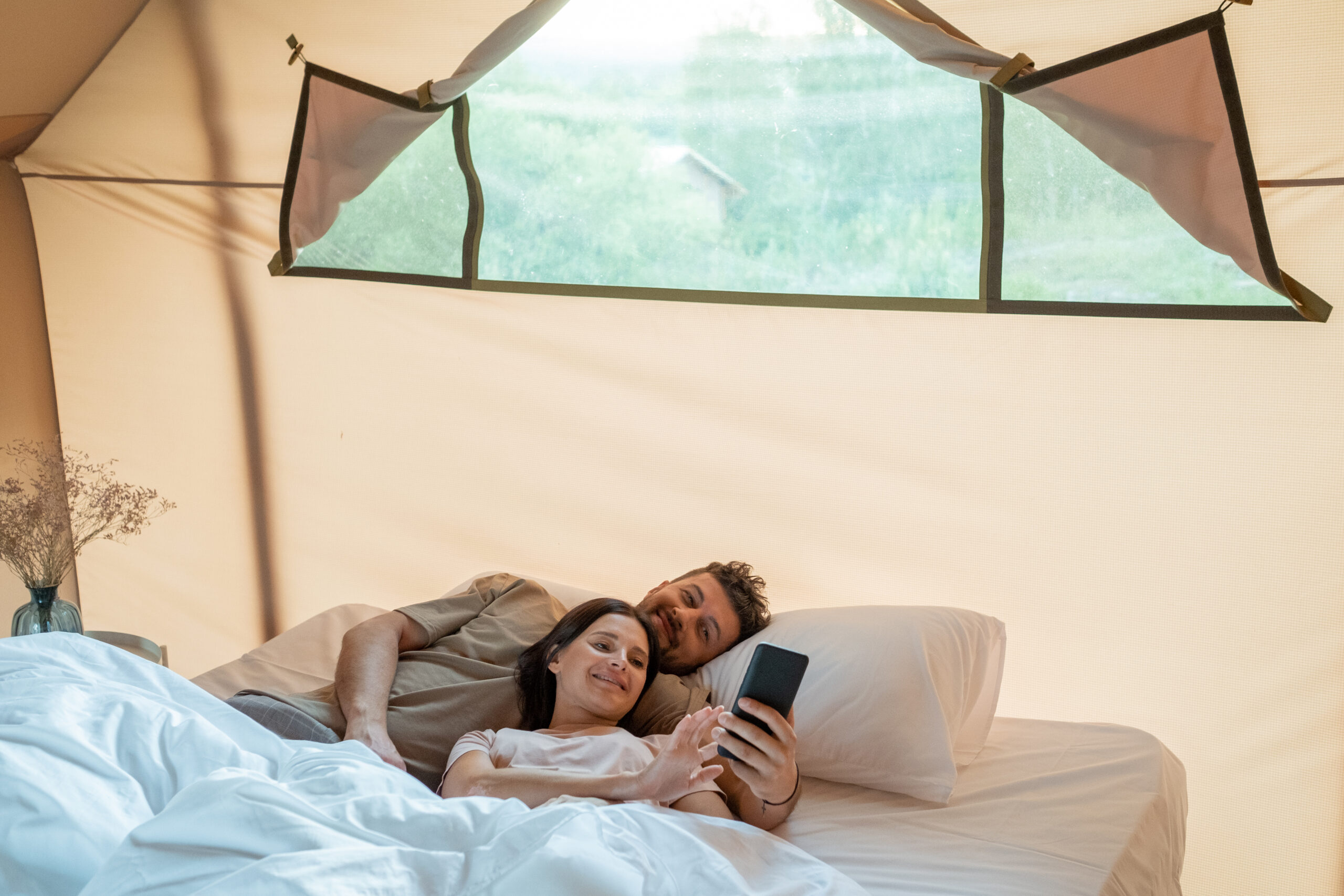This blog post may contain affiliate links. As an Amazon Associate I earn from qualifying purchases.
A good night’s sleep can make all the difference when you’re camping. But a good night’s sleep isn’t just about being comfortable, it’s also about being warm enough. The cold can ruin a night in your tent and leave you feeling unrested and grumpy in the morning. Fear not! In this guide, I’m going to cover all the ways I use to keep myself, my air mattress, tent, and sleeping bag warm while I’m camping.
Choose the Right Location
The first thing to think about when you want to stay warm in your tent is where you are choosing to set up your tent. Choosing the right location to camp can make a big difference to how cold you get during the night. Consider the following;
-
- Weather Forecast
Before you go camping, always check the weather forecast. This can help inform your choice of campsite, which clothing to wear, and which gear to pack to stay warm.
- Weather Forecast
-
- Wind Shelters
Wind can significantly reduce the perceived temperature. Choose a campsite which is nestled among trees or while is next to a natural windbreak like a hill or a rock formation.
- Wind Shelters
-
- Avoid Cold Spots
Cold air settles in low-lying areas while warm air rises. Choose a campsite which is slightly elevated to avoid cold spots.
- Avoid Cold Spots
-
- Sun Exposure:
Consider the direction of the sunrise and choose a campsite which receives some morning sun. This will help dry out camping gear and will help keep your tent warm throughout the day.
- Sun Exposure:
Insulate Under Your Air Mattress
Having a barrier between my mattress and the cold ground is absolutely essential. Even if your mattress doesn’t feel cold when you first lie down, after a whole night on the cold ground, it will. Here are some of the options for insulation which I recommend;
-
- Foam Pads
Closed-cell foam pads are a great choice. They are lightweight and offer an affordable insulation option. Make sure they have a thickness of at least ½ inch (1.3cm) if you are camping in colder climates.
- Foam Pads
-
- Inflatable Camping Mats
If you have space to carry one, an inflatable camping mat gives you even more insulation than a foam pad. I always keep on of these in my car as they are a little too bulky to carry with me when I’m on foot.
- Inflatable Camping Mats
-
- Blankets
If you don’t have a purpose-made mat, you can always use a thick wool or fleece blanket to give you an extra layer of insulation. It’s a low-tech solutions, but it worked for our ancestors!
- Blankets
Use a Quality Sleeping Bag
Your sleeping bag is the most important part of staying warm while camping. I’d rather be in a good sleeping bag in a bad tent than be in a bad sleeping bag in a good tent. The most important factors to consider are;
-
- Temperature Rating
Every sleeping bag should have a temperature rating which indicates its warmth level. Make sure you pick a sleeping bag with a rating that matches the environment you are camping in.
- Temperature Rating
| Warmth Rating | Temperature Range (°F) | Temperature Range (°C) | Description |
| Summer | Above 32°F | Above 0°C | Suitable for warm weather camping. |
| 3-Season | 20°F to 32°F | -6°C to 0°C | Versatile for spring, summer, and fall camping. |
| Winter | 0°F to 20°F | -18°C to -6°C | Designed for cold weather and mild winter conditions. |
| Extreme Winter | Below 0°F | Below -18°C | Suitable for extreme cold and winter expeditions. |
| Alpine/Expedition | Below -20°F | Below -29°C | Designed for high-altitude mountaineering and polar expeditions. |
-
- Down vs. Synthetic
Down is the most effective material for warmth-to-weight ratio, but it is absorbent and is less effective when wet. Synthetic bags are heavier but also perform better in damp camping conditions.
- Down vs. Synthetic
-
- Proper Closure
Using your sleeping bag’s hood and cinch cord properly will help you retain heat in your sleeping bag. Practice closing these so that you can do it in the dark.
- Proper Closure
Employ Proper Layering
Layering your clothing in a smart manner is a great way of keeping warm while still being able to cool down when you need to (by removing a layer)
There is a basic layering philosophy which I stick to, and which has never failed to keep me both warm and comfortable;
-
- Base Layer
I start with a layer of moisture-wicking clothes. Merino wool or synthetic. These draw sweat away from my skin and keep me dry and comfortable.
- Base Layer
-
- Mid-Layer
The mid layer is to keep warmth trapped in. I like to have a fleece jacket or a puffy down vest.
- Mid-Layer
-
- Outer Shell
The final, outer layer is designed to protect from the elements. I usually wear either a waterproof or windproof outer layer.
- Outer Shell
-
- Extremities
A good quality hat, a warm pair of socks, and a pair of gloves are all essentials which can easily be added to removed depending on how hot you are.
- Extremities
Heat Sources (Use with Caution!)
Additional heat sources can help to make your tent, sleeping bag, mattress, or clothes warmer. However, you need to be careful. Anything which generates heat is a potential hazard and can also cause condensation in your tent (which brings its own set of problems).
Here are some options for heat sources which I have found useful over my years of camping.
-
- Hot Water Bottles
Filling a hot water bottle and then wrapping it in a towel and placing it in my sleeping bag an hour before I plan on going to sleep is a great way of making sure my sleeping bag is nice and warm.
- Hot Water Bottles
-
- Heated Blankets
Portable, battery-powered heated blankets or USB heated blankets (which can be powered from a USB power bank) are a good addition to your camping gear. These are a good pairing with a solar-powered USB power bank so you can charge it up during the day and then stay warm at night.
- Heated Blankets
-
- Chemical Hand Warmers
These can be a great pick me up when you are feeling cold. I find these are most useful when you are hiking but you can also use them at night for a bit of extra warmth. I like to get reusable ones which can be reset with boiling water once you get home.
- Chemical Hand Warmers
Tent Setup and Ventilation
Tent ventilation, or the lack of it, can have a big impact on how warm I am while camping.
-
- Proper Pitching
Pitch your tent correctly, following its instructions. It needs to be free of gaps so that there are no drafts.
- Proper Pitching
-
- Minimize Vents
While ventilation is necessary for the tent, try to close most (or all) of the vents at night and open them during the day to air the tent out.
- Minimize Vents
-
- Double-Wall Tents
This is my preferred tent design. Double wall tents have an inner mesh layer and an outer fabric layer. This helps keep rain out while still allowing some ventilation.
- Double-Wall Tents
Food and Hydration
The food you eat can have a big impact on how warm you are when you are camping.
Energy-Rich Foods
Meals and snack which are rich in complex carbohydrates and healthy fats can help your body generate heat throughout the night.
Hydration is Key
You feel colder when you are dehydrated. Sip warm beverages in the evening to keep you hydrated and warm. I particularly like hot chocolate when I’m camping.
Final Thoughts – Keep Your Mattress Warm While Camping
Staying warm during a camping trip can be the difference between a fun weekend and a miserable one. Remember to use a combination of the approaches in this blog to find the one that works for you. Stay warm, stay safe, and happy camping!
FAQs
What are some tips for choosing a campsite to stay warm at night?
Selecting the right campsite can make a big difference in how warm you stay. Look for areas sheltered from the wind, such as sites nestled among trees or near natural barriers like hills or rock formations. Avoid low-lying areas, as cold air tends to settle there, and aim for a spot that receives some morning sun to help warm up your tent.
What type of insulation is recommended for an air mattress?
To insulate your air mattress from the cold ground, consider using a closed-cell foam pad, an inflatable camping mat, or even a thick wool or fleece blanket. Each option creates a barrier that helps retain warmth, ensuring a more comfortable night’s sleep.
What’s the best way to layer clothing to stay warm while camping?
Start with a moisture-wicking base layer, followed by a warm mid-layer like a fleece or down vest, and finish with an outer shell that’s windproof or waterproof. Don’t forget warm accessories like a hat, gloves, and socks for added warmth and flexibility in adjusting to the temperature.
How can I safely add extra heat inside my tent or sleeping bag?
Portable heat sources can add warmth, but use them cautiously. Hot water bottles wrapped in towels, battery-powered heated blankets, or chemical hand warmers can help keep you cozy. Be mindful of ventilation to prevent condensation, and always follow safety guidelines with heat sources inside the tent.


